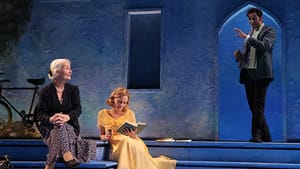Stay in the Loop
BSR publishes on a weekly schedule, with an email newsletter every Wednesday and Thursday morning. There’s no paywall, and subscribing is always free.
Roundabout Theatre's 'Indian Ink'

Sir Tom Stoppard is a fearless time-traveler. He hops back and forth between 1809 and 1993 from one scene to the next in his masterpiece, Arcadia, set on an idyllic English country estate. He sails through three decades of dense, 19th-century Russian intellectual history with a cast of 40 in his nine-hour epic trilogy, Coast of Utopia. He introduces three historical figures — Lenin, Tristan Tzara, and James Joyce — who all lived in Zurich in 1917 but had never officially met, in Travesties. He tracks parallel lives on separate continents (in England and Czechoslovakia) during the dark decades of communism, in Rock ‘n’ Roll.
With the revival of his 1995 play Indian Ink in New York, we once again marvel at his vision, as he connects the lives of two sisters in two specific places and times: 1930 in India and 1980 in England. Imagine telling a story of two sisters wherein the elder, Flora, is played by an actress in her early 30s (a radiant Romola Garai) and the younger, Eleanor, is played by an actress in her 80s (an equally radiant Rosemary Harris) — and it works. Therein you have Stoppard’s dramatic genius.
Getting people wrong
Stoppard weaves an exotic mystery, wherein Eleanor, the younger sister, now in her 70s, is being interviewed in her home in England (in 1980) by an eager researcher named Eldon Pike (note Stoppard’s mischievous penchant for character names that sound as if they come straight from a Clue board game). Pike is writing a biography of Eleanor’s older sister Flora, a poet who died in 1930 in India while in her 20s. “Biography is the worst possible excuse for getting people wrong,” scoffs the salty Eleanor, who is reluctant to cooperate.
But Pike is persistent. He wants to read Flora’s letters to Eleanor, written a half century ago, to uncover the following mysteries: 1) Did Flora, a flamboyant eccentric, pose in the nude for an Indian artist named Coomaraswami while in India (an occurrence that would have been scandalous for both, back in the day); and 2) Did they actually have, in Pike’s hesitant words, “a relationship”?
As Eleanor and Pike struggle to piece together the truth in the present, the play flashes back 50 years to 1930, where we see Flora living in Jamapur, India, where she’s been sent by her English doctors to convalesce and where she’s posing for a formal (clothed) portrait painted by the admiring Coomaraswami. While the scenes shift back and forth between 1930 and 1980 as the mystery unravels, Stoppard often keeps characters from both time frames onstage. So we witness how memory, biography, and history actually work. The final epiphany is not only the characters’, it’s ours as well.
“So . . . big!”
As always, Sir Tom offers a theatrical feast. Indian Ink is not only an absorbing mystery, it’s also a “passage to India,” an immersion in an exotic culture with which the British have had a long and complicated love affair. Augmented by Neil Patel’s colorful scenic design and Carey Perloff’s delicate direction, the play takes us to a world with a different tempo, aesthetic, and sensibility. No wonder Flora Crewe, whose poetry dealt with sex, fell under the spell of its eroticism (or “rasa”, as her painter calls it, referring to the “juice, taste, and essence” of all art). “This country is so . . . big!” marvels Pike, who himself is drawn to India to unravel the mystery.
Indian Ink also has a Shavian streak, offering a gentle, satirical jab at the snobbery of England’s upper class, from which Flora was exiled for her rugged individualism and daring verse.
In the penultimate scene of the play, there’s a moment when the two sisters cross the bridge of time and actually face each other at Flora’s graveside in India. It’s one of those Stoppardesque moments when you see two characters connect — one alive, one dead, one older and yet meant to be younger than the other — and the mysteries of time are revealed. It’s a magical moment that words cannot describe. It’s a moment that can only happen in the theater.
What, When, Where
Indian Ink by Sir Tom Stoppard. Carey Perloff directed. At the Roundabout Theatre Company, Laura Pels Theatre, 111 W. 46th Street, New York. Now playing through November 30. 212-719-1300 or www.roundabouttheatre.org.
Sign up for our newsletter
All of the week's new articles, all in one place. Sign up for the free weekly BSR newsletters, and don't miss a conversation.
